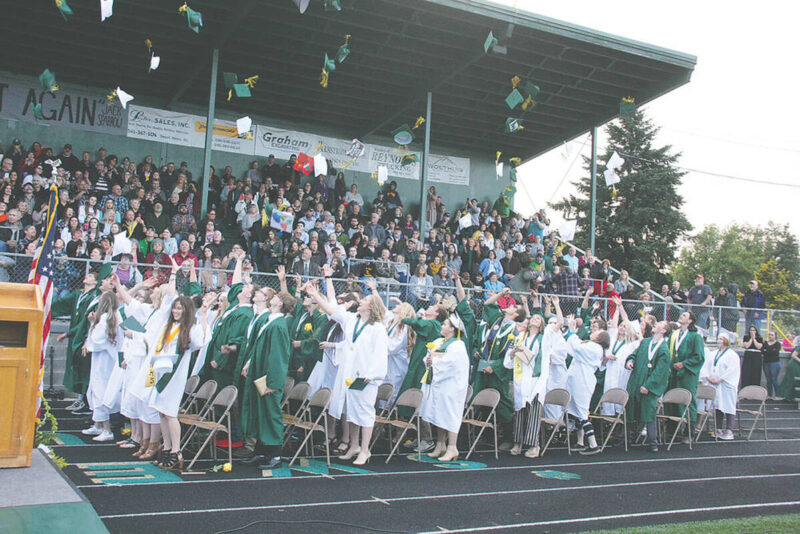Sean C. Morgan
Based on Oregon Department of Education data, Sweet Home High School’s graduation rate for last year’s Class of 2019 increased by more than 13.5 percentage points from the previous year.
The ODE released graduation data Thursday, Jan. 23, showing SHHS rising from a graduation rate of 70.83 percent in 2017-18 to 84.52 percent in 2018-19. Preliminary district data last fall had showed at least an increase of 10 points. Statewide, the graduation rate was 80.01 percent, an increase from 78.68 percent in 2017-18.
The graduation rate, called the four-year graduation cohort, measures how many freshmen in a specific class have reached graduation. Completing a diploma or GED within four years, called the four-year cohort completer rate, were 85.71 percent of the class.
Sweet Home’s five-year cohort completer rate, those who finish a diploma or alternative within five years, increased from 71.98 percent to 82.14 percent from 2017-18 to 2018-19.
The increase in the graduation rate was the largest increase among school districts with enrollment of more than 900 students and second among all school districts with enrollment of more than 600 students.
That’s a relatively large gain for a larger district. Rates in smaller districts can vary wildly, upward of 50 percentage points, when a small number of students graduate or fail to graduate.
“We haven’t had a gain like that in one year,” said Supt. Tom Yahraes. That kind of growth isn’t unreasonably high, not “when I think about all the different things we’ve done as a district. The effort has been ongoing over the past couple of years. I just want to emphasize this is a we thing.
“I am very proud of our staff and the students, who show perseverance and grit in the face of challenges and adversity. Extraordinary work, high school. And great work to our entire K-12 system and team in preparing students for high school. I am very proud of our entire high school staff, who believes in all mean all. We don’t give up on students. And I am proud of students who persevere. Every year we move (again prove) ourselves, and we aim to do that.
“It is our ultimate goal for our K-12 students to walk cross the stage senior year, achieving a diploma, ready for career or college, ready and prepared to continue to thrive personally as well as contribute to their communities.”
“We worked very hard,” said Assistant Principal Chris Hiaasen. “It was definitely a joint effort. Our goal was to see how much of an impact we could make. We were very, very deliberate about what we paid attention to. We had a lot of discussion about how much we could move these numbers and get parents and kids to buy in.”
The key is “everyone working on it,” she said. That includes everyone from the superintendent and Principal Ralph Brown to the staff.
Noting that “big jumps” never happen, a cautious Brown said he likes to look at three- to five-year averages, that rates like this will fluctuate a little. The district had a three-year average of 71 to 75 percent, but he believes that the school will soon have a new higher three-year average graduation rate.
“We’re at a threshold for a new plateau,” Brown said. “What I don’t know is what that number’s going to be. We just roll up our sleeves and get started again.”
A remarkable statistic among the data, Yahraes said, is that some 79 percent of disadvantaged and homeless students graduated.
“We know that nearly half of the students who experience homelessness do not graduate,” he said.
About two years ago, Sweet Home school officials were taking notice of West Albany High School, which is graduating more than 98 percent of its freshmen after four years, Yahraes said.
“We studied their models and techniques,” Yahraes said. “Beyond all the individualized efforts from our entire team to make a difference in our students’ lives, over the last year and a half we revamped our systems, practices and remediation efforts. In addition, we have been good stewards of Measure 98 funds in using them in targeted ways to directly impact kids. The return on the investments, I believe, has resulted in a high percentage of our students graduating.”
The district and the high school staff looked at the systems in place and began tracking individual students, Brown said. They took special notice of the ninth-grade-on-track statistic, which is directly correlated to graduation rates.
Among those credited with last year’s success, Hiaasen pointed to Darren Perry’s Ninth Grade Success Program, which has directly help increase the number of ninth graders on track to graduate.
The district established a high school CARE team, including counselors, administrators, student advocates and a study success coordinator, Yahraes said. That team meets monthly and tracks every student and their progress.
For students who are off track or who go off track, the team builds strategies to assist them, Yahraes said. It is a deliberate process that builds in accountability for students and adults.
Twice a week, a rotating staff of teachers hosts homework clubs where all students are welcome.
The district initiated a winter school during Christmas break and summer school to help students who fall just short of a passing a class, Yahraes said. Instead of failing a student who scores 58 percent, high school staff work with the student on the standards and curriculum the student needs to pass the class.
Measure 98 funds provides funding for staff that directly impacts students, he said. For example, a re-engagement specialist meets with students who have severe credit deficiencies or on the verge of dropping out. Retired counselor Jim Kistner works at the high school on individualized re-engagement plans with each student to get each one back on track.
The school is using credit retrieval in place of a true alternative education program, said Kistner, who is working as a re-engagement specialist.
They may take online courses, complete blended coursework or pursue a GED or alternative education pathway.
The district also created two student advocate positions. The advocates, classified staff members, meet with struggling students and assess what their barriers might be. They review homework, help organize student studies and meet with teachers to gain clarity on missing work.
Leah Norris and Heather Shipp, the classified student advocates, have done a lot of one-on-one work with a lot of students, Hiaasen said.
“That’s been very successful.”
“The district has decided to put a major effort into this,” Kistner said. “We developed a team that is working really, really well to solve problems. To keep this going, we need to find ways to reach out to these kids.
“It’s been an ongoing process. This starts at the top. They said we need to make it a priority.”
The team “is really making connections with the kids,” he said. “You show them a plan that’s workable. You make sure you’re connecting with them as often as possible, a minimum of two to three times a week. You never give up on a student.”
Kistner said he depends on the large number of teachers who are willing to put in extra time, adding he’s gotten help from every department.
“They’ve all seen this is a problem and find ways to help students catch up their credits,” he said, and they’re juggling their schedules to ensure they’re available after school for the homework clubs or team meetings.
Kistner texts 10 to 15 students every day, noting that the program is individualized, based on each student’s needs. “We’re finding ways to get these kids to not just give up.”
Yahraes said the district has used Measure 98 funding to increase career and technical education coursework.
“We know historically, these courses are more highly attended and motivate students to attend school.”
He is cautiously optimistic, he said.
“We want to make sure and replicate it. We want to continually refine our system and make sure we are repeating those successes. We do not want it to be an anomaly. We want this to be a way of life.”
The higher these statistics get, the harder it is to improve them, Yahraes said, and he thinks it would be “wonderful” to be talking about gains of 2 or 3 percent in the future.
Kistner is hoping to continue building on the successes of the past couple of years, he said, noting that on-track-to-graduate statistics this year are similar to those last year at the same point.
The school is focusing on getting freshmen and sophomores caught up early, he said. That way they won’t need to catch up as juniors and seniors with graduation looming.
Seeing the excitement among students who struggled but were able to graduate has been the biggest reward for the district’s efforts, he said.
The high school has systems in place, Brown said. Each class of students comes with a different personality, which staff members are still trying to figure out, but the system is giving each of those classes an “excellent chance for success.”
While the systems now in place are good, Brown said, “I do believe that we’re honing those systems,” to make sure they work for every single kid. “We still have a whole lot of challenges. The work is still very challenging work, but I’ve got people we can believe in.
“I’m excited about the future. Each kid is important. I think we’re doing a much better job looking at each kid. I’ve been blessed to have an incredible team, probably the best one I’ve had in my career.”





